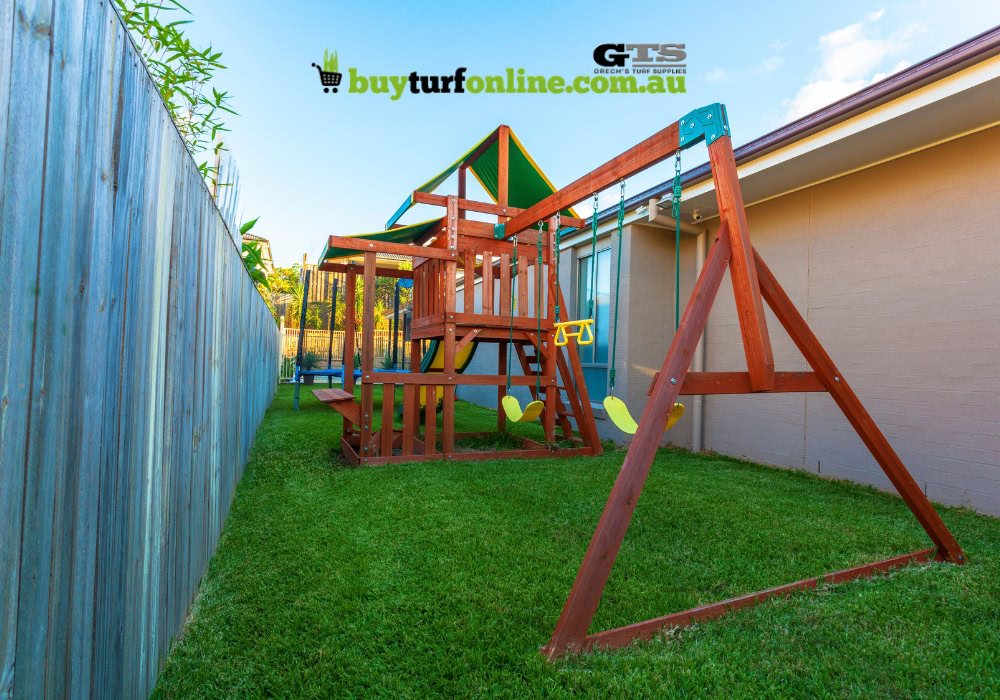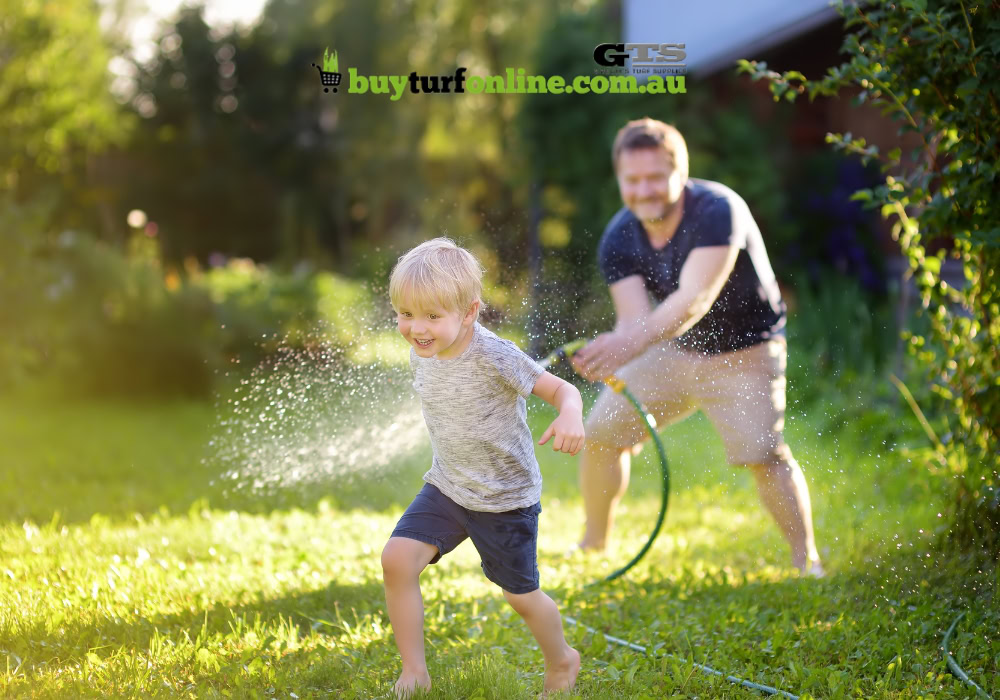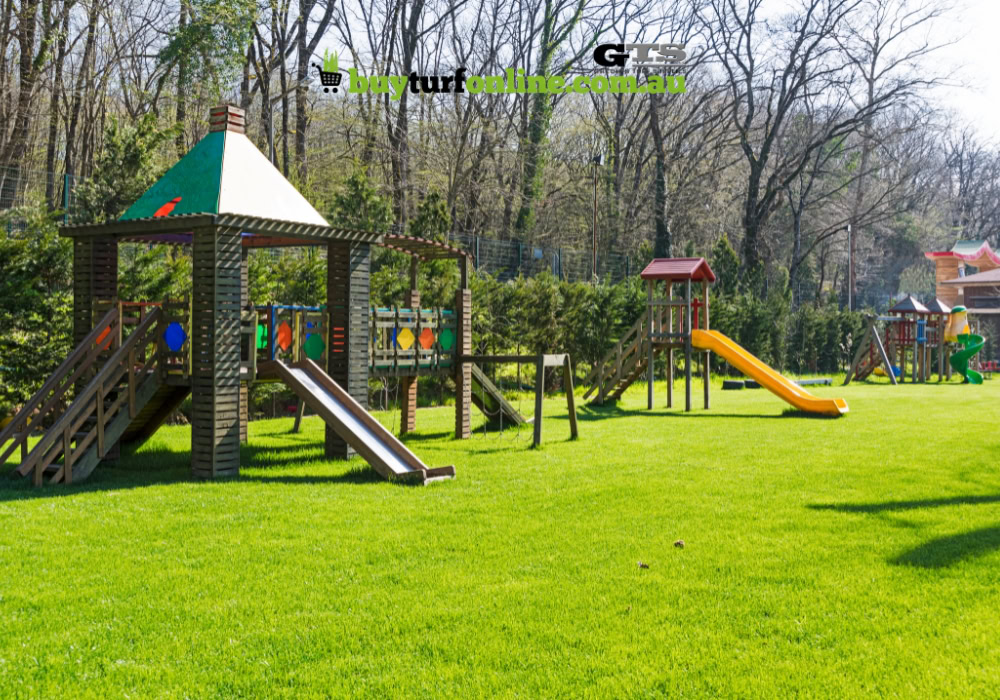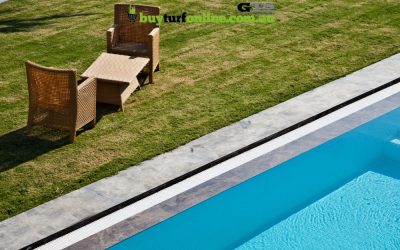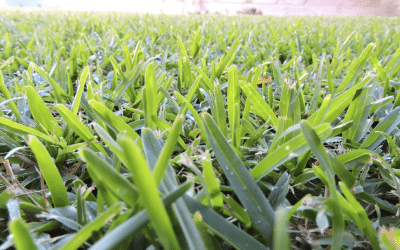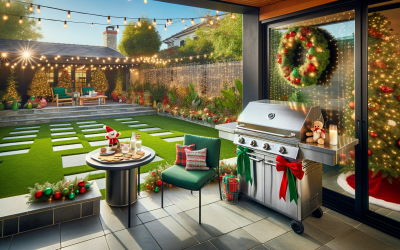Enhancing Backyard Play Areas for Kids with Turf
Can you put a playset on turf? You bet you can!
Natural grass is the perfect surface for creating a safe and fun play area. With the right approach, you can make sure your turf stands up to kids’ adventures while looking great all year round.
Let’s explore how to build a playground that’s both practical and durable without adding extra work to your plate.
Why Grass is the MVP of Playground Surfaces
Let’s be honest: kids can be rough on a lawn. Between trampolines, swing sets, and general cartwheeling chaos, your turf takes a beating. Here’s why natural grass deserves the title of “Playground MVP”.
It’s safer (and softer)
While kids can be tough on a lawn, natural grass remains the best surface for play areas. One of its greatest benefits is safety. Grass provides a soft, cushioned surface that helps prevent injuries when children fall, unlike the unforgiving nature of concrete or even synthetic playground turf.
It stays cool
Grass also stays cool, even during the peak of summer, making it far more comfortable than synthetic grass, which can heat up to unbearable temperatures under the sun.
It’s easy on the eyes (and the planet)
From an aesthetic and environmental perspective, natural grass has no equal. Its lush, green appearance complements any backyard, while its eco-friendly, biodegradable qualities mean you’re not adding plastic to the environment.
It’s kid-approved
And, of course, grass has an irresistible charm for kids. Grass stains and a little mud may seem like nuisances, but they’re often a sign of a backyard well-loved by children at play.
Unlike synthetic turf, grass invites kids to connect with nature, and there’s no risk of burns or scrapes from hard surfaces.
Choosing the Right Grass for the Job
Not all types of grass are created equal, especially for high-traffic play areas. Choosing the right variety is crucial to ensure your lawn stays lush and resilient.
Sir Walter Buffalo Grass
DNA Certified Sir Walter Buffalo grass is an excellent choice for play areas because it’s soft on little feet and tough enough to handle frequent use. And, if allergies are a concern, Sir Walter grass is worth considering. Its hypoallergenic qualities mean kids can play freely without sneezing or skin irritation.
Eureka Kikuyu
Eureka Kikuyu grass is another standout option—it grows and recovers quickly from wear and tear. As well as this, it’s a cost-effective choice – making it great for areas around swing sets and trampolines.
Pro tip: Pair your turf choice with good drainage to keep it green, mud-free, and ready for action year-round.
Natural grass vs. artificial grass for play areas
Synthetic grass might seem like a convenient option, but it has its drawbacks. Artificial turf tends to overheat, lacks the natural cushioning of real grass and doesn’t offer the same eco-friendly benefits. Find out more about choosing between artificial grass and real grass in our guide.
For landscapers and homeowners who value safety, comfort and sustainability, real grass is the way to go. Properly installed and well-maintained natural grass creates a play area that’s not only durable but also inviting for kids and adults alike.
Reinforcing High-Traffic Zones
Some parts of the lawn will naturally see more action, especially the areas around playground equipment like swing sets and trampolines. Without a little reinforcement, these zones can quickly wear down. Here’s how to keep your lawn looking sharp around playground equipment.
Install turf reinforcement mesh
Installing turf reinforcement mesh in high-traffic areas is a smart way to protect the grass from damage. This hidden layer of support prevents soil compaction and keeps the grass healthy and strong.
Rotate play equipment
Rotating equipment, such as moving swing sets or slides every few months, also gives the grass a chance to recover and prevents one patch from becoming completely worn out.
Use protective mats
For added protection, breathable mats can be placed under equipment like slides or swings. These mats shield the turf from direct impact while allowing water to drain through, which prevents muddy patches from forming.
Anchoring Playground Equipment the Smart Way
When it comes to installing playground equipment, stability is key. Proper ground anchors keep everything secure, reducing the risk of shifting or tipping that could lead to accidents.
Twist-in anchors are a reliable and easy-to-use solution. They can be quickly installed by pre-drilling a pilot anchor hole with a power drill, and then twisting the anchor into place.
For heavier equipment or larger structures like swing sets, concrete anchors are a great option. These require a bit more effort, including levelling the ground and pouring concrete, but the result is a secure base that can handle serious playtime.
Keep the Turf Breathing
Active play can compact the soil beneath a lawn, which makes it harder for grass to thrive. To keep your turf in good shape, regular aeration is essential.
Using a garden fork or lawn aerator, create small holes to loosen up the soil and allow air, water, and nutrients to penetrate the roots.
In areas where the soil is especially compacted, applying a thin layer of sand can make a big difference. Sand helps loosen the soil further, improving drainage and preventing water from pooling in high-use areas.
It’s also important to give parts of your lawn a break now and then. If possible, rotate the location of play equipment or encourage kids to use different areas to allow the grass to recover.
Seasonal Turf TLC
Keeping your playground surface lush all year doesn’t have to be a hassle. With a few seasonal care routines, you can ensure your lawn stays healthy and green while being low maintenance.
Spring
In spring, give the grass a boost with a nitrogen-rich fertiliser. This encourages new growth and helps repair any damage from winter.
Summer
During summer, mow the grass slightly higher to protect the roots from heat and reduce water evaporation. Check for any loose anchors or tripping hazards to keep the play area safe.
Autumn
Autumn is the perfect time to overseed any patchy spots and address wear and tear. It’s also a good idea to inspect and reinforce equipment anchors if the ground has shifted.
Winter
In winter, minimise heavy use of the lawn, as growth slows during colder months, making it more susceptible to damage.
So, can you put a playset on turf? Absolutely—and when you do it the smart way, you’ll create a safe, durable, and downright delightful playground area. With the right turf, a little reinforcement, and some seasonal care, your backyard can handle anything the kids throw at it (even the occasional mud pie).
Whether you’re installing swing sets, trampolines, or other playground equipment, a lush lawn is the perfect foundation for fun and safety.
Ready to Green Up Your Playground Surfaces?
The same turf trusted on playground and sports fields across NSW is also the foundation for safe, durable community play surfaces in parks and playgrounds.
From small neighbourhood playgrounds to large council reserves, we’ll deliver turf that’s safe, durable, and ready to perform.
Business Logins for Landscapers & Wholesale Customers
Approved customers get access to 24/7 online ordering, wholesale pricing, and live stock availability on our website with a Business Login. It’s the easiest way for landscapers, councils, and contractors to keep projects moving without delays.
read more!
recent posts
Poolside Turf: Choosing and Maintaining Grass Around Pools
There’s nothing quite like stepping out of a swimming pool onto soft, lush grass. But when it comes to finding the best grass for around a pool, not all lawns are created equal. Chlorine pools, heavy foot traffic, and the unforgiving Australian sun can take a toll on...
Soft Leaf Buffalo Grass
Find out why soft-leaf buffalo grass is such a popular lawn choice in Australia, the number 1 buffalo grass choice and how to look after a new soft-leaf buffalo lawn.
Preparing for Christmas Lunch in the Garden
Quick LinksCleaning Up and Preparing Your Backyard Choosing Garden Games for Christmas Day Preparing the BBQ for Christmas DayWith the holiday season just around the corner, it's time to embrace the true Aussie spirit and take your Christmas lunch outdoors. Picture...

Our Turf
TifTuf Bermuda
Buy Turf Online © 2025 All Rights Reserved. | Proudly Designed and Developed by Sydney ICT

